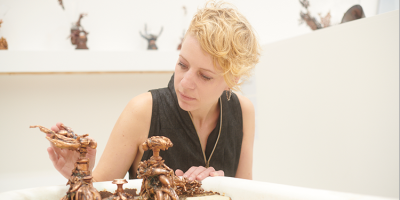

Katrin Spranger
Future Heritage
Information
Katrin Spranger is a visual artist working with sculpture, jewellery and performance. She creates dystopian narratives that engage with the environment, consumer culture and science fiction.
Focusing on natural resources threatened with depletion, Spranger modifies materials and their properties to suit a variety of different applications. Past practice has included the development of crude oil into jewellery that melts on the body as well as the 3D-printing of honey into edible art. Forging different experiences for viewer and wearer, Katrin's interactive pieces comprise permanent and deteriorative elements that critique societal norms of beauty and value.
With a background in traditional goldsmithing, Katrin holds a Master of Fine Arts from Konstfack University, Stockholm. As co-founder of the K2 Academy of Contemporary Jewellery, she teaches art and design qualifications in London.
At Future Heritage
For Future Heritage in 2018, she collaborated with Chadder & Co, a Royal Warrant Holder and bath refurbishing company. An original Victorian bathtub was re-purposed, and parts were transformed and electroformed to create a large-scale water sculpture. In addition to the bath, she designed and made a set of 6 drinking sculptures that were shown next to previous pieces from the Aquatopia collection.
Current work
For her recent project ‘Camden Alive,’ she received a grant to work with residents from the local neighbourhoods of Holborn and Camden. Workshops were conducted, to teach the technique of electroforming and to learn about her practice. Each resident brought an object that told a story about its owner and embodied a value personal to them. They then electroformed these objects, which were then added to the fountain frame, to create a futuristic, bejewelled and fully functioning, water fountain. To celebrate the project, participants’ works and the fountain were exhibited at the British Museum in March 2020.
Spranger’s most recent work, Aquatopia, adopts a critical view of our freshwater supply, its increasing demand and pollution. Inspired by traditional water systems, the futuristic Aquatopia objects re-appropriate original plumbing parts and laboratory found objects in order to reimagine familiar drinking vessels, scooping bowls, faucets and storage, including a bath. Made from copper and glass, the Aquatopia objects are produced via electroforming: a process in which alayer of copper is deposited on a conductive surface. Decorative, plant-like formations on each vessel reflect life's dependency on water.